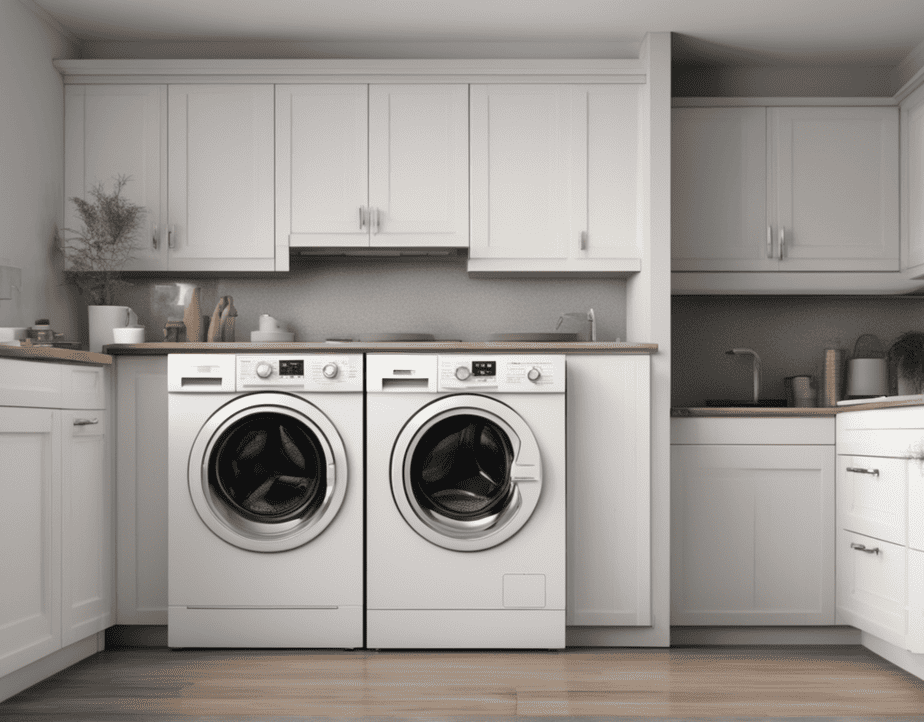Top Load vs Front Load Washing Machines (A Comparison)
We’re reader-supported; we may earn a commission from links in this article.
In the world of appliances, the top load vs front load washing machine debate is a hot topic. As a consumer, the choices can feel overwhelming.
But fear not!
In this friendly guide, we’ll break down the differences, pros, and cons of each type, helping you make an informed decision that suits your laundry needs.
So put down your laundry basket for a moment and let’s dive into the world of washing machines!
What is a Top Load Washing Machine?
Top load washing machines, as the name suggests, are loaded with laundry from the top.
hey are the traditional type of washer, and you’ll find they come in two main styles: those with an agitator (a tall spindle in the middle of the drum), and high-efficiency models without an agitator.
They’re generally easy to load and unload, and you can add items mid-cycle in most models.
Top load washing machines typically have a shorter wash cycle, making them a great choice for those who prefer to get their laundry done quickly.
What is a Front Load Washing Machine?

Front load washing machines are loaded from the front, and typically have a larger capacity than top loaders.
They use tumbling action instead of an agitator to clean clothes, which can result in better cleaning performance and greater energy efficiency.
They also have a higher spin speed, meaning clothes come out drier, reducing drying time. However, they may require more bending and kneeling to load and unload.
Comparing Top Load and Front Load Washing Machines
When comparing top load and front load washing machines, it’s clear that both have their unique strengths and potential drawbacks.
Top loading machines offer convenience in terms of loading and unloading, as they require less bending and kneeling. They generally have a higher capacity and shorter cycle times. However, they tend to use more water and energy, which could impact your utility bills and your environmental footprint.
On the other hand, many front load washers are superb in efficiency, using less water and energy per cycle. They are also generally quieter and provide a better cleaning performance.
These machines are gentle on fabrics and have higher spin speeds, which means your clothes come out drier and require less time in the dryer. However, they often come with a higher initial price tag and might be costlier to repair.
In choosing between a top load machine and front load washer, consider factors such as your budget, space requirements, laundry habits, and personal preferences.
Remember, the best machine for you is the one that fits your individual needs and lifestyle.
Refer to this table for a comparison of front load vs top load washers.
| Feature | Top Load Washing Machine | Front Load Washing Machine |
|---|---|---|
| Loading Style | Clothes loaded from top | Clothes loaded from front |
| Capacity | Generally higher | Generally lower |
| Water Usage | More water required | Less water required |
| Energy Efficiency | Less energy efficient | More energy efficient |
| Cleaning Performance | Agitates clothes | Tumbles clothes |
| Gentle on Fabrics | Not as gentle | Gentle on fabrics |
| Cycle Length | Shorter cycles | Longer cycles |
| Noise Level | Louder | Quieter |
| Price Range | Generally lower | Generally higher |
| Space Requirements | Requires less space | Requires more space |
| Maintenance and Repairs | Easier to maintain | May be costlier to repair |
Note: This table is a general comparison and may vary depending on the specific make and model of washing machines.
Deciding Which Washing Machine is Best for You
Now that you know the differences between top load and front load washing machines, it’s time to reflect on what’s more important for you.
Do you prioritize efficiency and performance?
Then, a front-load washer might be your best bet. If convenience and speed are at the top of your list, then a top-load washer could be the perfect fit.
Consider the layout of your laundry space. Front-load washers can be stacked with a dryer to save space, while top-load washers need adequate overhead clearance. Don’t forget to think about the long-term costs, such as water and electricity usage.
Also, remember that technology is always evolving. Both types of washers are constantly improving, with manufacturers adding new features and making modifications to enhance user experience and efficiency.
So, take your time, do your research, and choose a washing machine that will make your laundry tasks easier and more efficient. Remember, there’s no right or wrong choice here – only what works best for you and your laundry needs!
My Personal Experience With Washing Machines
In my personal experience, I’ve owned both top load and front load washers and found value in each. However, I lean slightly towards front load washing machines.
They’re remarkably efficient, and I’ve noticed a decrease in my monthly utility bills since making the switch.
The superior cleaning performance is also a major plus, and my clothes always come out feeling fresh and thoroughly cleaned.
That being said, finding what works best for your unique needs and preferences is essential. The key is to balance the practical aspects with your personal priorities to find the perfect fit.
Maintenance for Top Load vs Front Load Machines
Maintenance is another crucial aspect to consider when deciding between top load and front load washing machines. Regular upkeep is vital for both types to ensure efficiency and prolong the lifespan of the appliance. Let’s look at how each type typically fares in terms of maintenance.
Frequently Asked Questions
Q1: Which type of washing machine is more durable, top load or front load?
Generally, both types of washing machines can be durable if cared for properly. However, most front load washers generally require more maintenance due to their design.
Q2: How often should I clean my washing machine?
Regardless of whether you own a top load or a front load washer, it’s recommended to clean your machine once a month to maintain its performance and hygiene.
Q3: Are front load washers better for clothes?
Front load washers use a tumbling action, which can be gentler on clothes than the agitators used in many top load washers. But remember, the “gentleness” also depends on the washing cycle and settings you choose.
Q4: What about the mold issue in front loaders?
Front loaders can have issues with mold due to the way they’re designed. However, by leaving the door open between cycles, using the right detergent, and regularly cleaning the machine, you can prevent mold build-up.
Q5: Can I add clothes mid-cycle in a front load washer?
While this is a standard feature for top load washers, some front load models now also offer a ‘pause’ function that allows you to add items mid-cycle. Do check your specific model for this feature.
Q6: Is there a significant difference in wash time between top load and front load machines?
Wash times can vary greatly depending on the specific model and settings you choose. However, top load machines generally have quicker cycle times than front loaders.
Final Thoughts
Whether you choose a top load or front load washing machine will ultimately depend on your individual needs and preferences. Both types come with their unique sets of benefits and potential drawbacks.
It’s essential to weigh these factors against your laundry habits, space constraints, budget, and efficiency needs.
Remember, the goal is to make your laundry chores as easy and efficient as possible, so choose a machine that aligns with your lifestyle and meets your laundry needs.
And always remember, the best washing machine for you is the one that makes doing laundry a breeze!

Justin Chia
Justin is the author of Justjooz and is a data analyst and AI expert. He is also a Nanyang Technological University (NTU) alumni, majoring in Biological Sciences.
He regularly posts AI and analytics content on LinkedIn, and writes a weekly newsletter, The Juicer, on AI, analytics, tech, and personal development.
To unwind, Justin enjoys gaming and reading.




